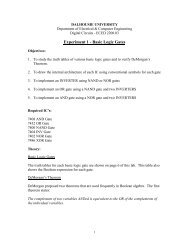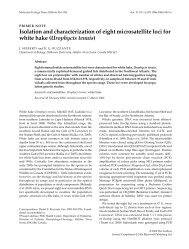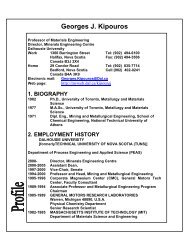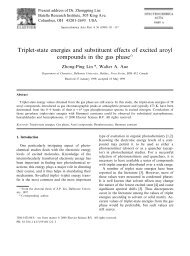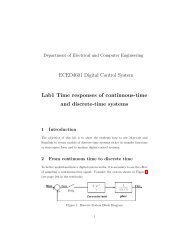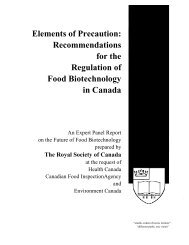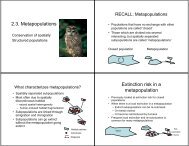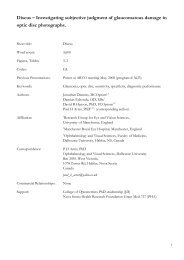Palladium-Catalyzed Mono-α-arylation of Acetone with Aryl Halides ...
Palladium-Catalyzed Mono-α-arylation of Acetone with Aryl Halides ...
Palladium-Catalyzed Mono-α-arylation of Acetone with Aryl Halides ...
You also want an ePaper? Increase the reach of your titles
YUMPU automatically turns print PDFs into web optimized ePapers that Google loves.
Received: January 1, 2011<br />
Published: March 18, 2011<br />
COMMUNICATION<br />
pubs.acs.org/JACS<br />
<strong>Palladium</strong>-<strong>Catalyzed</strong> <strong>Mono</strong>-r-<strong>arylation</strong> <strong>of</strong> <strong>Acetone</strong> <strong>with</strong> <strong>Aryl</strong> <strong>Halides</strong><br />
and Tosylates<br />
Kevin D. Hesp, † Rylan J. Lundgren, † and Mark Stradiotto*<br />
Department <strong>of</strong> Chemistry, Dalhousie University, Halifax, Nova Scotia, Canada B3H 4J3<br />
bS Supporting Information<br />
ABSTRACT: We report the first example <strong>of</strong> selective Pdcatalyzed<br />
mono-R-<strong>arylation</strong> <strong>of</strong> acetone employing aryl<br />
chlorides, bromides, iodides, and tosylates. The use <strong>of</strong><br />
appropriately designed P,N-ligands proved to be the key<br />
to controlling the reactivity and selectivity. The reaction<br />
affords good yields <strong>with</strong> substrates containing a range <strong>of</strong><br />
functional groups at modest Pd loadings using Cs2CO3 as<br />
the base and employing acetone as both a reagent and the<br />
solvent.<br />
Transition-metal-catalyzed R-<strong>arylation</strong> <strong>of</strong> carbonyl and related<br />
compounds has emerged as a useful and powerful<br />
strategy for the formation <strong>of</strong> sp 3<br />
sp 2 carbon carbon bonds. 1<br />
Despite considerable progress in the field, most notably from the<br />
groups <strong>of</strong> Hartwig, 2 Buchwald, 3 among others, 4 the identification<br />
<strong>of</strong> catalysts capable <strong>of</strong> the selective mono<strong>arylation</strong> <strong>of</strong><br />
enolates employing a broad range <strong>of</strong> unbiased aryl halides has<br />
remained a persistent challenge. The mono<strong>arylation</strong> <strong>of</strong> enolates<br />
derived from acetate esters, 5 methyl aryl ketones, 2a,3a,c,5a,6<br />
acetonitrile, 7 and dimethylacetamide 2b <strong>with</strong> unbiased reaction<br />
partners has been established; however, the analogous selectivity<br />
<strong>with</strong> acetone, the simplest ketone substrate, still represents a<br />
significant challenge that has not been addressed to date. 8<br />
Key obstacles to the selective mono<strong>arylation</strong> <strong>of</strong> acetone include<br />
the fact that the R-aryl methyl ketone products still possess<br />
several reactive C H bonds that can undergo further C C bondforming<br />
reactions, thus leading to mixtures <strong>of</strong> polyarylated products,<br />
even when acetone is employed in excess. 9 Moreover, the ketone<br />
products following the initial <strong>arylation</strong> reaction are inherently more<br />
reactive toward subsequent <strong>arylation</strong> chemistry because <strong>of</strong> the<br />
increased acidity <strong>of</strong> the remaining R-C H bonds, thereby resulting<br />
in more facile enolate formation. Additionally, reductive elimination<br />
from the key Pd(II)aryl(enolate) species has been demonstrated<br />
to be slower when less sterically demanding ketone substrates are<br />
employed. 10 Although the challenges posed by acetone in R<strong>arylation</strong><br />
chemistry have been circumvented through the use <strong>of</strong><br />
preformed stannyl or silyl acetone enolates (Figure 1 A,B), 11 such<br />
strategies employing acetone equivalents are not ideal from efficiency<br />
or economic standpoints, given the requirement <strong>of</strong> extra<br />
synthetic steps and the use <strong>of</strong> stoichiometric tin or zinc reagents.<br />
Alternatively, similar R-aryl methyl ketones have recently been<br />
prepared using a CuI-mediated <strong>arylation</strong>/C C bond cleavage<br />
process that involves the reaction <strong>of</strong> β-diketones <strong>with</strong> aryl bromides<br />
and iodides (Figure 1C). 12 In this regard, the use <strong>of</strong> acetone as a<br />
reagent for the selective synthesis <strong>of</strong> R-aryl methyl ketones<br />
(Figure 1D) represents an unmet challenge in metal-mediated R<strong>arylation</strong><br />
catalysis. Herein we report a Pd catalyst system and reaction<br />
conditions that allow, for the first time, the direct <strong>arylation</strong> <strong>of</strong><br />
acetone <strong>with</strong> a diverse range <strong>of</strong> aryl halides and tosylates <strong>with</strong><br />
excellent mono<strong>arylation</strong> selectivity.<br />
Our initial efforts focused on the identification <strong>of</strong> suitable<br />
reaction conditions for the Pd-catalyzed selective mono<strong>arylation</strong><br />
<strong>of</strong> acetone <strong>with</strong> 4-chlorotoluene (1a) using a catalyst system that<br />
we previously showed to display good mono<strong>arylation</strong> reactivity<br />
<strong>with</strong> small amines (Table 1). 13 The use <strong>of</strong> [Pd(cinnamyl)Cl] 2,<br />
L1 (Mor-DalPhos), and a 1:1 acetone/Cs2CO3 mixture (in<br />
4-fold excess relative to 1a) in 1,4-dioxane provided the desired<br />
monoarylated methyl ketone product (2a) in 37% yield (Table 1,<br />
entry 1). Further investigation into the reaction parameters<br />
revealed that both the catalytic activity and monoselectivity were<br />
highly sensitive to the components <strong>of</strong> the catalyst system. 14 The<br />
choice <strong>of</strong> palladium source proved to be quite significant, as<br />
replacement <strong>of</strong> [Pd(cinnamyl)Cl]2 <strong>with</strong> either Pd(OAc)2 or Pd-<br />
(dba)2 resulted in
Journal <strong>of</strong> the American Chemical Society COMMUNICATION<br />
Figure 1. Comparison <strong>of</strong> (A C) previous metal-catalyzed methods for<br />
the selective synthesis <strong>of</strong> R-aryl methyl ketones from acetone equivalents<br />
and (D) the method described in the present work.<br />
(L6), cataCXium-A (L7), and IPr (L8), as well as the bisphosphine<br />
Josiphos (L11) gave comparatively poor results, <strong>with</strong> low<br />
conversions <strong>of</strong> the starting aryl chloride to mainly polyarylated<br />
products. Although the use <strong>of</strong> tBu-XPhos (L4), bis(di-tert-butylphosphino)ferrocene<br />
(DTBPF) (L9), or QPhos (L10) provided<br />
modest conversions <strong>of</strong> 1a under our standard conditions, the<br />
poor selectivity observed for the desired mono<strong>arylation</strong> product<br />
further highlights the utility <strong>of</strong> L1 for the selective synthesis <strong>of</strong> Raryl<br />
methyl ketone 2a.<br />
Having defined a highly effective catalyst system and reaction<br />
conditions for the selective mono<strong>arylation</strong> <strong>of</strong> acetone <strong>with</strong> 4-chlorotoluene,<br />
we sought to explore the scope <strong>of</strong> the reaction for other<br />
aryl (pseudo)halides (Table 2). The R-<strong>arylation</strong> <strong>of</strong> acetone <strong>with</strong><br />
electron-rich and electron-neutral aryl chloride substrates proceeded<br />
to the corresponding monoarylated methyl ketone<br />
products 2b e in good to excellent yields (78 98%) when<br />
2 3 mol % Pd (1 1.5 mol % [Pd(cinnamyl)Cl] 2) was<br />
employed in neat acetone at 90 °C. 15 Electron-poor aryl chlorides,<br />
such as 4-chlorobenzotrifluoride, could also be employed<br />
successfully (2f, 70%). Substrates featuring benzyl-protected<br />
(2h) or free alcohol (2i) functional groups as well as those <strong>with</strong><br />
geminally disubstituted olefin(2j) or tertiary amine (2k) groups<br />
also provided the desired ketone products <strong>with</strong> excellent monoselectivity.<br />
<strong>Aryl</strong> chlorides containing N-heterocycles, such as<br />
pyridine (2l), pyrrole (2m), or N-benzylindole (2n), were also<br />
readily converted into the corresponding ketones in good to<br />
excellent yields (72 96%). Furthermore, aryl chloride substrates<br />
featuring alternative enolizable sites, such as benzyl and homobenzyl<br />
esters (2o and 2p) or an acetanilide group (2q), were<br />
employed successfully in the chemoselective mono<strong>arylation</strong> <strong>of</strong><br />
acetone <strong>with</strong> useful yields (66 84%).<br />
<strong>Aryl</strong> bromides and iodides were also found to be suitable substrates<br />
for the selective mono<strong>arylation</strong> <strong>of</strong> acetone employing<br />
[Pd(cinnamyl)Cl]2 and L1 (Table 2). Though electron-rich<br />
(2r) and sterically crowded (2s) aryl bromides were readily<br />
converted to the corresponding R-aryl methyl ketones (88 and<br />
72%, respectively), the use <strong>of</strong> electron-poor aryl bromides, such<br />
as 4-bromobenzonitrile, surprisingly proved to be much more<br />
problematic (2t, 33%). A benzylic nitrile substrate, which features<br />
an alternative enolizable site, was chemoselectively converted to the<br />
desired ketone 2u. Heteroaromatic substrates, such as 3-bromothiophene,<br />
2-bromo-N-benzylpyrrole, 5-bromo-N-benzylindole,<br />
and 4-bromo-N-Boc-indole, were also suitable reaction partners<br />
(2v y). This protocol was also shown to be amenable to largescale<br />
reactions, as a 67% yield (1.2 g) <strong>of</strong> 2z was obtained after<br />
reduction <strong>of</strong> the product ketone by NaBH4 when the reaction was<br />
Table 1. Optimization <strong>of</strong> the Pd-<strong>Catalyzed</strong> <strong>Mono</strong>selective<br />
r-<strong>Aryl</strong>ation <strong>of</strong> <strong>Acetone</strong> <strong>with</strong> 4-Chlorotoluene a<br />
entry ligand acetone:base b<br />
t (h) conv. (%) yield <strong>of</strong> 2a (%)<br />
1 L1 4:4 2 45 37<br />
2 c<br />
L1 4:4 2 77 48<br />
3 L1 4:8 2 85 52<br />
4 L1 10:2 5 >99 89 d<br />
5 e<br />
L1 10:2 48 >99 61<br />
6 f<br />
L1 10:2 48 78 71<br />
7 L2 10:2 5 90 60<br />
8 L3 10:2 5 47 44<br />
9 L4 10:2 5 56 12<br />
10 L5 10:2 5 38 11<br />
11 L6 10:2 5 38 6<br />
12 L7 10:2 5
Journal <strong>of</strong> the American Chemical Society COMMUNICATION<br />
Table 2. Scope <strong>of</strong> the <strong>Palladium</strong>-<strong>Catalyzed</strong> r-<strong>Aryl</strong>ation <strong>of</strong><br />
<strong>Acetone</strong> <strong>with</strong> <strong>Aryl</strong> Chlorides, Bromides, Iodides, and<br />
Tosylates a<br />
a Conditions: 0.5 M ArX in acetone at 90 °C for 4 16 h, ArCl:Cs2CO3 =<br />
1:2, [Pd]:L1 = 1:2. Yields are <strong>of</strong> isolated material. The<br />
[Pd(cinnamyl)Cl]2 loading (mol %) is indicated in parentheses. b<br />
ArCl:Cs 2CO 3 = 1:3, [ArCl] = 0.25 M. c 1 H NMR yield relative to 1,4bis(trifluoromethyl)benzene<br />
as an internal standard. d Isolated in a<br />
combined 70% yield <strong>with</strong> the direct <strong>arylation</strong> product (4.6:1). e Yield<br />
<strong>of</strong> corresponding alcohol after reduction <strong>with</strong> NaBH 4, performed on a<br />
10 mmol scale.<br />
[Pd(cinnamyl)Cl]2 and 4 mol % L1 along <strong>with</strong> 2 equiv <strong>of</strong> Cs2CO3<br />
and 10 equiv <strong>of</strong> acetone (relative to the aryl chloride), the initial<br />
rates <strong>of</strong> reaction for 4-chloroanisole, 4-chlorotoluene, and 4-chlorobenzotrifluoride<br />
were monitored. 17 The results from this study<br />
were consistent <strong>with</strong> those from the scope study: the use <strong>of</strong><br />
more electron-rich aryl chloride substrates provided higher rates<br />
<strong>of</strong> catalysis. This trend also translated to competition reactions<br />
involving combinations <strong>of</strong> different aryl chlorides (eq 1), where it<br />
was observed that mixtures <strong>of</strong> more electron-rich aryl chlorides<br />
Table 3. Ligand Screening for the <strong>Palladium</strong>-<strong>Catalyzed</strong> r-<br />
<strong>Aryl</strong>ation <strong>of</strong> <strong>Acetone</strong> <strong>with</strong> Electron-Deficient<br />
4-Bromobenzonitrile a<br />
a Reaction conditions: 0.5 M ArBr in acetone at 90 °C for 16 h, ArBr:<br />
Cs2CO3 = 1:2. Yields are <strong>of</strong> isolated material.<br />
proceeded to higher average conversions (R1 =OMe,R2 =Me;<br />
35% after 2 h) than those <strong>of</strong> electron-poor substrates (R1 =Me,R2<br />
=CF3; 14% after 2 h). Moreover, the favored product in each<br />
competition experiment was the R-aryl methyl ketone derived from<br />
the more electron-deficient aryl chloride, despite the fact that the<br />
electron-rich substrates reacted to form product more rapidly in the<br />
individual rate studies. The presence <strong>of</strong> electron-poor aryl chlorides<br />
appears to inhibit the R-<strong>arylation</strong> <strong>of</strong> more electron-rich substrates;<br />
presumably, this is a result <strong>of</strong> more facile oxidative addition <strong>of</strong><br />
the electron-poor aryl chloride followed by a low rate <strong>of</strong> reductive<br />
elimination, effectively inhibiting the catalyst from reacting <strong>with</strong><br />
electron-rich arenes. Collectively, these results suggest that the reactivity<br />
issues <strong>with</strong> electron-deficient substrates must arise in either<br />
the transmetalation or reductive elimination steps <strong>of</strong> the catalytic<br />
cycle. 1c<br />
On the basis <strong>of</strong> the hypothesis that C C reductive elimination<br />
<strong>of</strong> electron-deficient arenes <strong>with</strong> the acetone enolate from an<br />
[(L1)Pd(CH 2COCH 3)(Ar)] intermediate may be slowed as a<br />
result <strong>of</strong> the heightened basicity <strong>of</strong> palladium, as suggested by the<br />
mechanistic studies <strong>of</strong> Culkin and Hartwig, 10 less electron-rich P,<br />
N-ligands were pursued in hopes <strong>of</strong> effecting these challenging<br />
transformations (Table 3). Substitution <strong>of</strong> the electron-rich di-1adamantylphosphino<br />
moiety for less basic diphenylphosphino<br />
(L12) and di-2-tolylphosphino (L13) groups facilitated increasingly<br />
significant improvements <strong>with</strong> regard to the isolated yield <strong>of</strong><br />
2t (from 33 to 62 and 84% yield, respectively) from 4-bromobenzonitrile.<br />
We propose that the combined electronic and steric<br />
properties <strong>of</strong> L13 help to promote the presumably difficult<br />
reductive elimination between electron-poor arenes and acetone<br />
enolates. Notably, the use <strong>of</strong> L13 under similar conditions for the<br />
R-<strong>arylation</strong> <strong>of</strong> acetone <strong>with</strong> electron-deficient aryl chlorides was<br />
not successful, because <strong>of</strong> the more challenging Ar Cl oxidative<br />
addition reaction when such triarylphosphine ligands are<br />
employed. 18<br />
Through the use <strong>of</strong> catalytic mixtures consisting <strong>of</strong> [Pd(cinnamyl)Cl]2<br />
and L13, a selection <strong>of</strong> electron-deficient aryl bromides<br />
were shown to be suitable reaction partners for the selective<br />
5196 dx.doi.org/10.1021/ja200009c |J. Am. Chem. Soc. 2011, 133, 5194–5197
Journal <strong>of</strong> the American Chemical Society COMMUNICATION<br />
Figure 2. Expanded scope for palladium-catalyzed R-<strong>arylation</strong> <strong>of</strong> acetone<br />
using electron-deficient aryl bromides. Reaction conditions: 0.5 M<br />
ArBr in acetone at 90 °C, ArBr:Cs 2CO 3 = 1:2, [Pd]/L13 = 1:2. Yields<br />
are <strong>of</strong> isolated material, and the [Pd(cinnamyl)Cl]2 loading (mol %) is<br />
indicated in parentheses. 2ff and 2hh were isolated as the corresponding<br />
alcohols following reduction using NaBH 4.<br />
mono<strong>arylation</strong> <strong>of</strong> acetone (Figure 2). The use <strong>of</strong> sterically<br />
hindered electron-deficient aryl bromides (affording 2ee) as well<br />
as those containing one or more electron-<strong>with</strong>drawing groups, such<br />
as fluoride, trifluoromethyl, or acyl (affording 2ff ii), proceeded<br />
selectively to the R-aryl methyl ketone products in good yield<br />
(64 74%). The reactivity pattern <strong>of</strong> Pd/L13 mixtures was exploited<br />
in the selective cross-coupling <strong>of</strong> 2-chlorobromobenzene to<br />
generate the corresponding chloro-substituted ketone, thereby<br />
providing an opportunity for subsequent Pd(0)-mediated coupling<br />
chemistry <strong>of</strong> the remaining aryl chloride (2jj). 19<br />
In summary, we have described the first example <strong>of</strong> the selective,<br />
Pd-catalyzed mono-R-<strong>arylation</strong> <strong>of</strong> acetone <strong>with</strong> aryl chlorides, bromides,<br />
iodides, and tosylates. The reaction makes direct use <strong>of</strong> a simple<br />
and abundant three-carbon feedstock <strong>with</strong>out the requirement <strong>of</strong><br />
stoichiometric additives or preformed enolates to generate R-aryl<br />
methyl ketones. In view <strong>of</strong> the excellent selectivity and functional<br />
group tolerance, the ease <strong>of</strong> conducting such reactions, and the<br />
relative mildness <strong>of</strong> the reaction conditions, we expect this protocol<br />
to be widely adapted in synthetic chemistry.<br />
’ ASSOCIATED CONTENT<br />
bS Supporting Information. Full experimental details and<br />
characterization data. This material is available free <strong>of</strong> charge via<br />
the Internet at http://pubs.acs.org.<br />
’ AUTHOR INFORMATION<br />
Corresponding Author<br />
mark.stradiotto@dal.ca<br />
Author Contributions<br />
† These authors contributed equally.<br />
’ ACKNOWLEDGMENT<br />
We thank the NSERC <strong>of</strong> Canada, the Killam Trusts, the<br />
Walter C. Sumner Foundation, and Dalhousie University for<br />
their generous support <strong>of</strong> this work. Pamela G. Alsabeh is<br />
acknowledged for late-stage experimental contributions.<br />
Dr. Michael Lumsden (NMR-3, Dalhousie) is thanked for<br />
assistance in the acquisition <strong>of</strong> NMR data.<br />
’ REFERENCES<br />
(1) (a) Bellina, F.; Rossi, R. Chem. Rev. 2010, 110, 1082.<br />
(b) Johansson, C. C.; Colacot, T. J. Angew. Chem., Int. Ed. 2010,<br />
49, 676. (c) Culkin, D. A.; Hartwig, J. F. Acc. Chem. Res. 2003, 36, 234.<br />
(2) (a) Kawatsura, M.; Hartwig, J. F. J. Am. Chem. Soc. 1999,<br />
121, 1473. (b) Shaughnessy, K. H.; Hamann, B. C.; Hartwig, J. F.<br />
J. Org. Chem. 1998, 63, 6546. (c) Hamann, B. C.; Hartwig, J. F. J. Am.<br />
Chem. Soc. 1997, 119, 12382.<br />
(3) (a) Fox, J. M.; Huang, X. H.; Chieffi, A.; Buchwald, S. L. J. Am.<br />
Chem. Soc. 2000, 122, 1360. (b) Åhman, J.; Wolfe, J. P.; Troutman,<br />
M. V.; Palucki, M.; Buchwald, S. L. J. Am. Chem. Soc. 1998, 120, 1918.<br />
(c) Palucki, M.; Buchwald, S. L. J. Am. Chem. Soc. 1997, 119, 11108.<br />
(4) (a) Muratake, H.; Hayakawa, A.; Natsume, M. Tetrahedron Lett.<br />
1997, 38, 7577. (b) Muratake, H.; Natsume, M. Tetrahedron Lett. 1997,<br />
38, 7581. (c) Satoh, T.; Kawamura, Y.; Miura, M.; Nomura, M. Angew.<br />
Chem., Int. Ed. Engl. 1997, 36, 1740.<br />
(5) (a) Biscoe, M. R.; Buchwald, S. L. Org. Lett. 2009, 11, 1773.<br />
(b) Hama, T.; Hartwig, J. F. Org. Lett. 2008, 10, 1545. (c) Jørgensen, M.;<br />
Lee, S.; Liu, X.; Wolkowski, J. P.; Hartwig, J. F. J. Am. Chem. Soc. 2002,<br />
124, 12557. (d) Moradi, W. A.; Buchwald, S. L. J. Am. Chem. Soc. 2001,<br />
123, 7996. (e) Lee, S.; Beare, N. A.; Hartwig, J. F. J. Am. Chem. Soc. 2001,<br />
123, 8410.<br />
(6) (a) Desai, L. V.; Ren, D. T.; Rosner, T. Org. Lett. 2010, 12, 1032.<br />
(b) Navarro, O.; Marion, N.; Oonishi, Y.; Kelly, R. A.; Nolan, S. P. J. Org.<br />
Chem. 2006, 71, 685.<br />
(7) You, J.; Verkade, J. G. Angew. Chem., Int. Ed. 2003, 42, 5051.<br />
(8) This is true despite some early developments in the field<br />
originating from the observation <strong>of</strong> R-arylated products when Pdcatalyzed<br />
cross-coupling reactions were conducted in acetone solvent<br />
(see ref 1c).<br />
(9) For the di<strong>arylation</strong> <strong>of</strong> acetone en route to oxime esters, see the<br />
Supporting Information for the following article: Tan, Y.; Hartwig, J. F.<br />
J. Am. Chem. Soc. 2010, 132, 3676.<br />
(10) (a) Culkin, D. A.; Hartwig, J. F. J. Am. Chem. Soc. 2001,<br />
123, 5816. (b) Culkin, D. A.; Hartwig, J. F. Organometallics 2004,<br />
23, 3398.<br />
(11) (a) Chobanian, H. R.; Liu, P.; Chioda, M. D.; Guo, Y.; Lin, L. S.<br />
Tetrahedron Lett. 2007, 48, 1213. (b) Su, W. P.; Raders, S.; Verkade,<br />
J. G.; Liao, X. B.; Hartwig, J. F. Angew. Chem., Int. Ed. 2006, 45, 5852.<br />
(c) Liu, P.; Lanza, T. J.; Jewell, J. P.; Jones, C. P.; Hagmann, W. K.; Lin,<br />
L. S. Tetrahedron Lett. 2003, 44, 8869. (d) Kosugi, M.; Suzuki, M.;<br />
Hagiwara, I.; Goto, K.; Saitoh, K.; Migita, T. Chem. Lett. 1982, 939.<br />
(12) He, C.; Guo, S.; Huang, L.; Lei, A. J. Am. Chem. Soc. 2010,<br />
132, 8273.<br />
(13) (a) Lundgren, R. J.; Peters, B. D.; Alsabeh, P. G.; Stradiotto, M.<br />
Angew. Chem., Int. Ed. 2010, 49, 4071. (b) Lundgren, R. J.; Stradiotto, M.<br />
Angew. Chem., Int. Ed. 2010, 49, 8686.<br />
(14) K 2CO 3 and Na 2CO 3 proved to be unsuccessful in promoting<br />
the reaction, and LiHMDS and NaOtBu provided intractable product<br />
mixtures in which negligible amounts <strong>of</strong> 2a were observed by use <strong>of</strong> GC.<br />
(15) In neat acetone, L11 also provided good results for <strong>arylation</strong><br />
<strong>with</strong> 1a (94% conv., 93% yield at 60 °C in 19 h).<br />
(16) The use <strong>of</strong> 3-(trifluoromethyl)phenyl tosylate resulted in the<br />
formation the corresponding phenol as the major product under the<br />
standard conditions.<br />
(17) See the Supporting Information.<br />
(18) (a) Barrios-Landeros, F.; Carrow, B. P.; Hartwig, J. F. J. Am.<br />
Chem. Soc. 2009, 131, 8141. (b) Littke, A. F.; Fu, G. C. Angew. Chem., Int.<br />
Ed. 2002, 41, 4176.<br />
(19) Preliminary studies also showed that L13 was capable <strong>of</strong> crosscoupling<br />
electron-rich aryl bromides (4-bromotoluene and 4-bromoanisole)<br />
under similar conditions.<br />
5197 dx.doi.org/10.1021/ja200009c |J. Am. Chem. Soc. 2011, 133, 5194–5197



